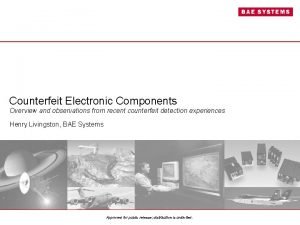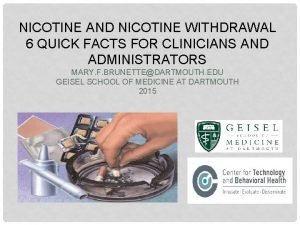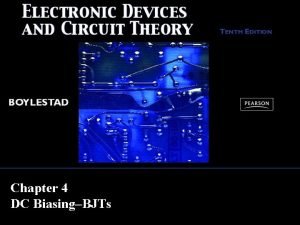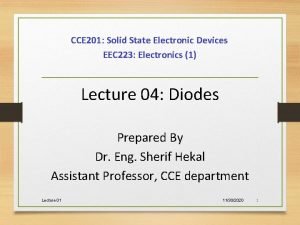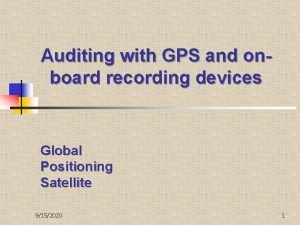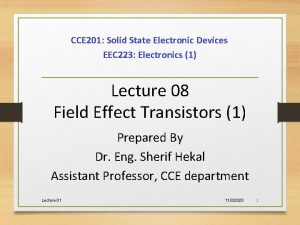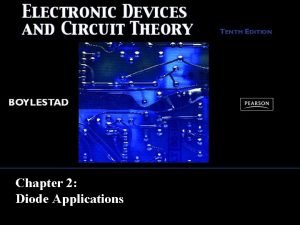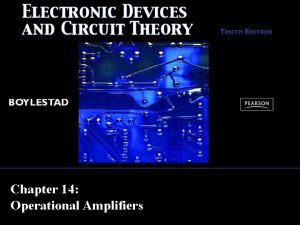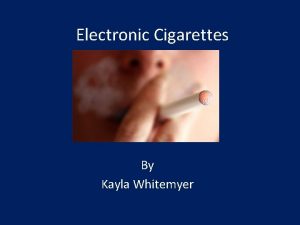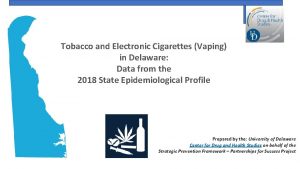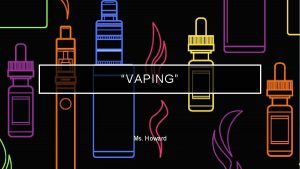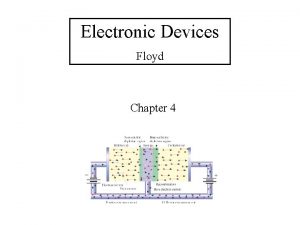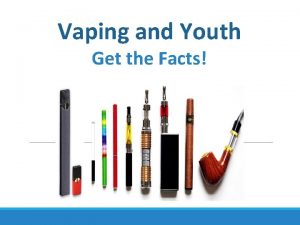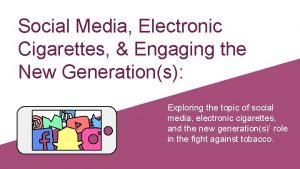Overview of Electronic Cigarettes Vaping Devices Disclaimer This





















- Slides: 21

Overview of Electronic Cigarettes & Vaping Devices

Disclaimer This presentation was prepared for the Mountain Plains Addiction Technology Transfer Center (ATTC) under a cooperative agreement from the Substance Abuse and Mental Health Services Administration (SAMHSA). All material appearing in this presentation, except that taken directly from copyrighted sources, is in the public domain and may be reproduced or copied without permission from SAMHSA or the authors. Citation of the source is appreciated. Do not reproduce or distribute this presentation for a fee without specific, written authorization from the Mountain Plains ATTC. For more information on obtaining copies of this presentation, call visit the website (https: //attcnetwork. org/centers/mountain-plains-attc/slidedecks 4 u). At the time of this presentation, Elinore F. Mc. Cance-Katz, serves as SAMHSA Assistant Secretary. The opinions expressed herein are the views of Nancy Roget, MS, MFT, LADC and Stephanie Pyle, Ph. D, and do not reflect the official position of the Department of Health and Human Services (DHHS), SAMHSA. No official support or endorsement of DHHS, SAMHSA, for the opinions described in this document is intended or should be inferred.

Electronic Cigarette Definitions • also called vapes, e-hookas, vape pens, tank systems, mods, and electronic nicotine delivery systems (ENDS) • are electronic devices that produce an aerosol by heating a liquid typically containing nicotine, flavorings, and other additives; users inhale this aerosol into their lungs • e-cigarettes also can be used to deliver tetrahydrocannabinol (THC), the principal psychoactive component of cannabis • use of e-cigarettes is commonly called vaping (Perrine et al. , 2019)

Examples of E-cig & Vaping Devices Photo from US Food and Drug Administration website: Vaporizers, E-Cigarettes, and other Electronic Nicotine Delivery Systems (ENDS)

New Type of E-cig/Vaping Devices USB • Small e-cigs and vaping devices are popular due to the minimal exhaled smoke (aerosol), reduced odor, and small size, making it easier to hide their use. • JUUL sells USB flash drive-shaped e-cig/vaping devices o o one of the most commonly sold USB flash drive shaped e-cigarettes experienced 600% increase in sales during 2016 -2017 had the greatest e-cigarette market share in the U. S. by the end of 2017 other companies are starting to sell e-cigs that look like USB drives the most commonly reported e-cigarette brand used by youth in 2019 Ramamurthi et al. , 2018; Cullen et al. , 2019

How e-Cigs & Vaping Devices Work Most e-cigs/vaping devices have 4 components: a cartridge, reservoir, or pod that holds a liquid solution (e-liquid or e-juice) containing varying amounts of nicotine, flavorings, and other chemicals • a heating element (atomizer) • a power source (usually a battery) • a mouthpiece that the person uses to inhale • In many e-cigarettes, puffing activates the battery-powered heating device, which vaporizes the liquid in the cartridge. The person then inhales the resulting aerosol or vapor (called vaping).

Parts of an e-cigarette device Photo from: US Department of Health and Human Services. E-cigarette use among youth and young adults. A report of the Surgeon General, 2016

The Aerosol that Users Breathe from the E-cigarette and Exhale can Contain Harmful and Potentially Harmful Substances • Volatile Organic Compounds • Nicotine • Cancer-causing Chemicals • Heavy Metals – nickel, tin, & lead • Ultrafine Particles • Flavoring such as Diacetyl • THC in some cases

CDC coined the term EVALI E-cigarette, or Vaping, product use Associated Lung Injury

CDC Data on Vaping/E-cigarette Injuries/Death As of November 20, 2019 • 2, 290 cases of e-cigarette, or vaping, product use associated lung injury (EVALI) have been reported to CDC • 49 states (all except Alaska), the District of Columbia, and 2 U. S. territories (Puerto Rico and U. S. Virgin Islands) have reported these lung injuries • 47 deaths have been confirmed in 25 states and the District of Columbia

Number of Lung Injury Cases Reported to CDC as of November 19, 2019 https: //www. cdc. gov/tobacco/basic_information/e-cigarettes/severe-lung-disease. html#map-cases

New Results on EVALI A CDC lab tested lung fluid from 29 patients from 10 states Vitamin E acetate was found in ALL of the samples • THC was identified in 82% of the samples • Nicotine was identified in 62% of the samples • CDC tested for a range of other chemicals that might be found in ecigarette, or vaping, products, including plant oils, petroleum distillates like mineral oil, MCT oil, and terpenes (which are compounds found in or added to THC products). None of these chemicals of concern were detected in the BAL fluid samples tested • https: //www. cdc. gov/tobacco/basic_information/e-cigarettes/severe-lung-disease. html#map-cases

Key Facts about Vitamin E Acetate • is used as an additive, most notably as a thickening agent in THC-containing e-cigarette, or vaping, products. • is a vitamin found in many foods, including vegetable oils, cereals, meat, fruits, and vegetables; also available as a dietary supplement and in many cosmetic products, like skin creams. • usually does not cause harm when ingested as a vitamin supplement or applied to the skin. However, previous research suggests when vitamin E acetate is inhaled, it may interfere with normal lung functioning.

Current Evidence & Decreasing Risks • While it appears that vitamin E acetate is associated with EVALI, evidence is not yet sufficient to rule out the contribution of other chemicals. • Many different substances and product sources are still under investigation; there might be more than one cause of this outbreak. • Decrease risk by refraining from use of all e-cigarette/vaping products. • Adults using e-cigarettes to quit smoking should not go back to smoking. They should weigh all risks and benefits and consider using FDA-approved nicotine replacement therapies. • People who have significant impairment or distress from ongoing problematic use of THC-containing e-cigarette, or vaping, products should seek evidence-based behavioral treatment and recovery services for cannabis use disorder.

CDC Recommends that people SHOULD NOT: • use e-cigarette or vaping products that contain THC • buy any type of e-cigarette or vaping products, particularly those containing THC, from informal sources such as friends, family, or in-person or online dealers • modify or add any substances to e-cigarette or vaping products that are not intended by the manufacturer, including but not limited to, vitamin E acetate and other cutting agents and additive products purchased through retail establishments. https: //www. cdc. gov/tobacco/basic_information/e-cigarettes/severe-lung-disease. html#map-cases

Use of E-cigs by High School and Middle School Students Based on a 2019 study, an estimated: • 4. 1 million high school students and 1. 2 million middle school students currently use e-cigarettes (Over 5 million adolescents) • 1. 6 million students reported frequent use of e-cigarettes • 970, 000 students use e-cigarettes daily • 2. 4 million exclusive e-cigarette users use flavored e-cigarettes Cullen et al. , 2019

Monitoring the Future Study and NIDA Director In 2019, the prevalence of past month nicotine vaping more than doubled… 1 in 4 students in 12 th grade • 1 in 5 in 10 th grade • 1 in 11 in eighth grade • Quote from Dr. Nora Volkow… “With 25% of 12 th graders, 20% of 10 th graders and 9% of eighth-graders now vaping nicotine within the past month, the use of these devices has become a public health crisis. These products introduce the highly addictive chemical nicotine to these young people and their developing brains, and I fear we are only beginning to learn the possible health risks and outcomes for youth. ”

For adolescents and young adults, there is no safe use of nicotine

In Summary… • • • Use of E-cigs and Vaping devices should not be used by adolescents, young adults, or pregnant women. THC is commonly used in these devices and, as the active ingredient in cannabis, is associated with the development of substance use disorders. New e-cig and vaping devices are being sold to represent pens, flash drives, chargers, etc. , which may help individuals hide their use of these devices. Individuals Should Not Use Vaping Cartridges from home-made sources, especially THC cartridges The evidence that e-cigs help adults using combustible tobacco is variable and requires more randomized control trials, although individuals should not return to using tobacco products. Check out the CDC, NIDA, SAMHSA, and FDA websites regularly to get updates or sign-up for their email notifications

Resources • The CDC website has numerous resources that are available and targeted to the general public and to health professionals • A six minute video is available on e-cigs 101 for clinicians and public health professionals • https: //www. youtube. com/watch? v=5 a. Li. Ir. PQn. Ac • The US Surgeon General’s website has lots of resources and a recent advisory

For more information, contact Thomasine Heitkamp, PI/Co-Director Nancy Roget, Co-Director University of North Dakota thomasine. heitkamp@und. edu University of Nevada, Reno nroget@casat. org www. mpattc. org
 Counterfeit electronic components an overview
Counterfeit electronic components an overview Scrip exchange
Scrip exchange Electronic field production
Electronic field production Withdrawal symptoms from cigarettes
Withdrawal symptoms from cigarettes Publicidad subliminal camel
Publicidad subliminal camel Brian cigarettes
Brian cigarettes Lev in significant cigarettes
Lev in significant cigarettes Why is adding menthol to cigarettes dangerous?
Why is adding menthol to cigarettes dangerous? Lev in significant cigarettes
Lev in significant cigarettes Family mart layout
Family mart layout Jin ling cigarettes
Jin ling cigarettes 365 ats cigarettes
365 ats cigarettes Client devices portfolio overview
Client devices portfolio overview Load line analysis of transistor
Load line analysis of transistor Solid state electronic devices 7th solution chapter 4
Solid state electronic devices 7th solution chapter 4 Electronic onboard recording devices
Electronic onboard recording devices Solid state electronic devices ppt
Solid state electronic devices ppt Boylestad
Boylestad Difference between majority and minority carriers
Difference between majority and minority carriers Perform surveillance without electronic devices
Perform surveillance without electronic devices Programmable electronic devices
Programmable electronic devices Boylestad
Boylestad
